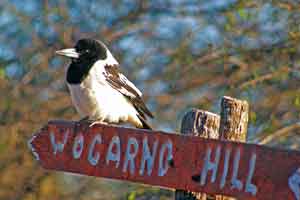Everyone wants to understand art. Why not try to understand the songs of a bird? Pablo Picasso. [1]

Pied butcherbird at Wogarno Station, WA. Photograph by Chris Tate.
Hoop pines, vine thickets, and a mesh of mangrove roots. Fringing coral reefs and fractured granite boulders. Where are we? Eight kilometres offshore from Townsville. It’s sunrise on Magnetic Island (‘Maggie’), the only arid island in the Great Barrier Reef. Breaking waves mix with a dawn chorus of tropical birds and insects, underscored by a pied butcherbird. S/he alternates between one and two notes. The insistent song can be likened to an ostinato, a simple, repeated, and largely unchanging pattern.(1) [2] As calling cards go, this one is all low-hype, high integrity prog chirp – but pied butcherbirds rarely sing this simply. In the background, we hear a conspecific with more virtuosic ambitions.
As we zero in on the neighbour, we get the sense that themes are sourced from a stock of rehearsed sonic units (2). Like human composers, each bird has an individual approach, a ‘bag of tricks’. Melody, rhythm, contour, and colour (timbral nuance) are pertinent, and a regular pattern of sound and silence is in evidence.
In their vocalisations, birds take each other’s stuff, use stuff, chop stuff up, re-stuff, and re-cycle – it’s a natural continuum. (It’s the way human musicians work as well.) Australian pied butcherbirds sing solo and in groups but lack a species-typical song. Instead, they craft novel re-combinations of their phrases, as well as mimic other species and sounds, even manmade ones, producing a unique and complex musical landscape. Their voice is described as rich, clear, mellow, magnificent, glorious, superb … the accolades flow.
[For more, read the special Arts of Sound November 2009 Issue of Art Monthly Australia www.artmonthly.org.au]
Hollis Taylor
Hollis Taylor was once the youngest member (violinist) of the Oregon Symphony and a concertmaster/soloist at Wolf Trap Center for the Performing Arts, Washington DC. She has performed and recorded jazz and folk music worldwide, and is an acclaimed clinician, teacher and lecturer. She is a regular contributor to magazines such as Strings, Fiddler, AudioWings and Stringendo. She co-authored the book/DVD with Jon Rose, Post Impressions: A Travel Book for Tragic Intellectuals (2007), which presents their Great Fences of Australia project.
References
[1] John Berger, The Success and Failure of Picasso, London: Writers and Readers, London, first published 1965, p. 29.
[2] The accompanying DVD contains a sampler of pied butcherbird song fragments and singing patterns from various contexts. The bracketed numbers throughout this article correspond with the track number on the DVD.
 This work is licensed under a Creative Commons Attribution-NonCommercial-ShareAlike 2.5 Australia.
This work is licensed under a Creative Commons Attribution-NonCommercial-ShareAlike 2.5 Australia.






